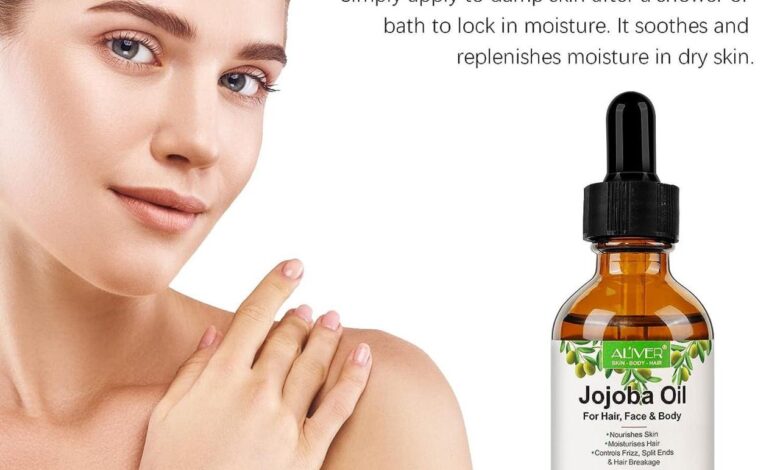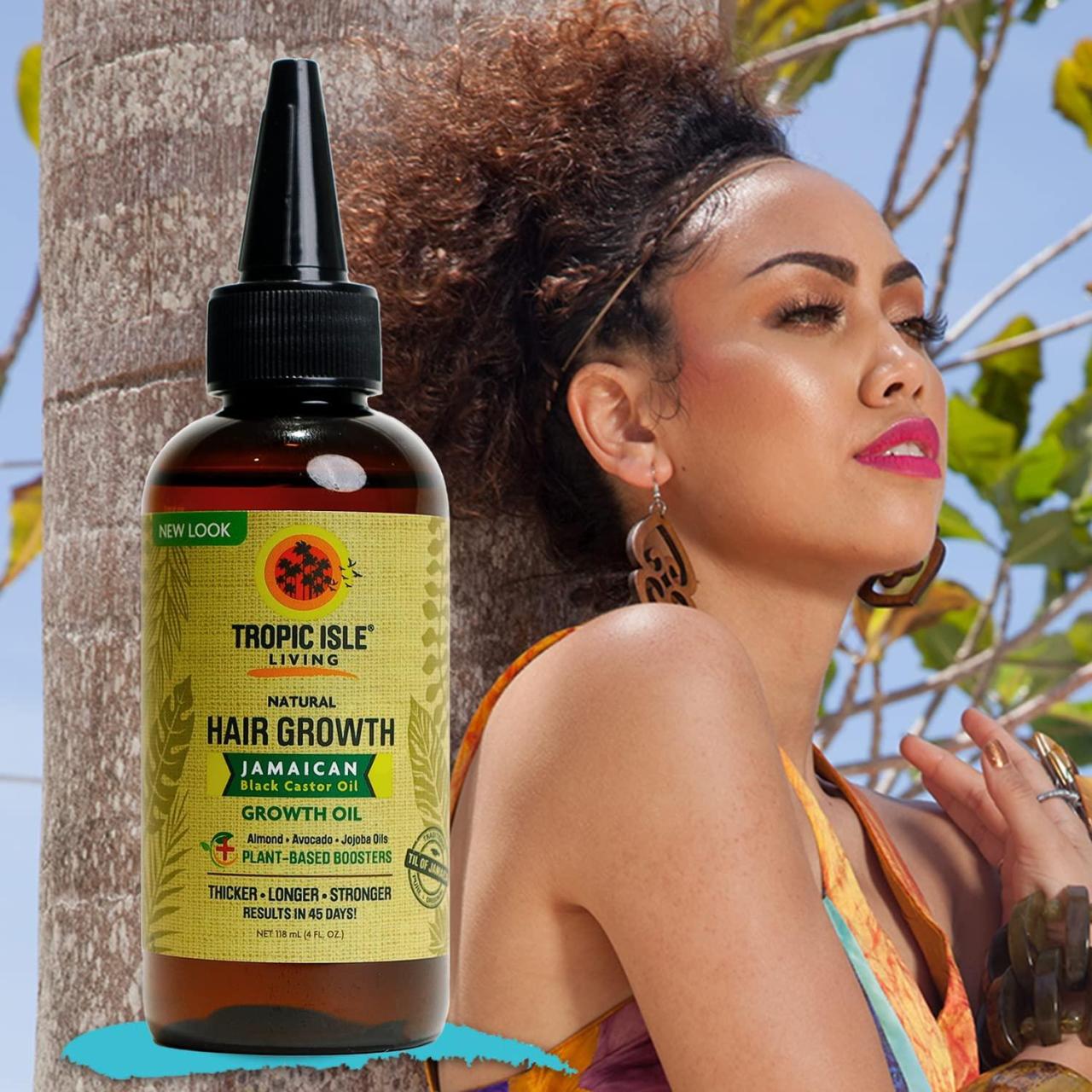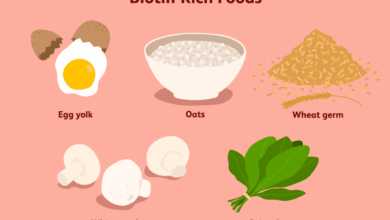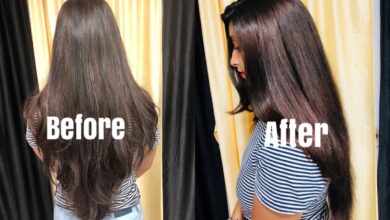
Best oils for hair growth are a popular topic for those seeking to enhance their hair’s health and appearance. From the nourishing power of essential oils to the versatile carrier oils, this comprehensive guide delves into the world of hair growth oils, providing insights into their benefits, application methods, and potential side effects. We’ll explore various types of oils, their individual properties, and how they can contribute to stronger, healthier hair follicles.
This in-depth exploration will cover everything from identifying the most popular essential oils for hair growth to understanding how carrier oils enhance their effectiveness. We’ll also delve into the science behind hair growth, examining research and studies on the topic. Finally, we’ll provide practical advice on choosing the right oils for your hair type and applying them safely and effectively.
Introduction to Hair Growth Oils

Oils play a crucial role in maintaining healthy hair, influencing everything from shine and softness to overall growth. Many natural oils contain essential fatty acids, vitamins, and antioxidants that can nourish the hair follicles and scalp, promoting a healthier environment for hair growth. This nourishing effect, along with their moisturizing properties, makes oils a popular choice for those seeking to improve hair health.Various types of oils are commonly used for hair growth, each with its unique composition and purported benefits.
Understanding the different types of oils and their potential contributions to hair health is key to selecting the right oil for individual needs. Oils can contribute to healthier hair follicles by moisturizing the scalp, preventing dryness and irritation, and potentially stimulating blood flow to the hair roots. These factors are all crucial components of healthy hair growth.
Common Hair Growth Oils
Natural oils have long been used for their moisturizing and nourishing properties, impacting both hair and scalp health. Understanding the composition and properties of these oils is essential for selecting the most appropriate type for your hair type and concerns.
- Jojoba Oil: This oil is remarkably similar in composition to the sebum naturally produced by the scalp. This similarity often leads to excellent compatibility and reduced irritation. Its non-comedogenic nature makes it a popular choice for those with oily or acne-prone scalps. It’s known for its moisturizing properties, potentially improving scalp health and promoting healthy hair growth.
- Coconut Oil: Rich in saturated fatty acids, coconut oil is known for its moisturizing and conditioning properties. It can help to hydrate the hair and scalp, potentially preventing dryness and breakage. Its antimicrobial properties can help combat dandruff and other scalp conditions. The high saturated fat content might make it less ideal for very fine or oily hair.
- Argan Oil: Known for its high concentration of vitamin E and fatty acids, argan oil is prized for its ability to nourish and condition hair. It can help to strengthen hair shafts, reducing breakage and promoting healthy growth. The oil’s moisturizing properties can also improve scalp health and reduce dryness.
- Castor Oil: Castor oil is often touted for its ability to stimulate hair growth. Its high concentration of ricinoleic acid is believed to promote blood circulation to the scalp, potentially stimulating follicles. However, its thick consistency can sometimes be challenging to work with and may leave hair feeling greasy.
Comparison of Hair Growth Oils
The following table provides a concise overview of common hair growth oils, highlighting their benefits and potential drawbacks.
| Oil Type | Benefits | Potential Drawbacks |
|---|---|---|
| Jojoba Oil | Similar to scalp sebum, often well-tolerated, non-comedogenic, moisturizing. | May not be as effective for very thick or coarse hair types. |
| Coconut Oil | Moisturizing, conditioning, antimicrobial properties. | May be heavy for fine or oily hair, potential for clogging pores. |
| Argan Oil | Rich in vitamins and fatty acids, strengthens hair, conditions. | Can be expensive, may not be suitable for all hair types. |
| Castor Oil | Potentially stimulates hair growth, promotes blood circulation. | Thick consistency, may leave hair greasy, not suitable for all hair types. |
Essential Oils for Hair Growth
Essential oils have long been touted for their potential to enhance hair growth. While many claim miraculous results, the scientific evidence supporting their effectiveness is often limited and sometimes contradictory. This exploration dives into the popular essential oils believed to promote hair growth, examining their purported mechanisms, potential risks, and available research.Beyond the alluring promises, understanding the nuances of essential oils’ impact on hair health is crucial.
Hair growth is a complex process involving multiple factors, and while these oils may offer some benefits, they shouldn’t be considered a magic bullet.
Popular Essential Oils for Hair Growth
Several essential oils are frequently recommended for hair growth. These include rosemary, tea tree, lavender, and peppermint, among others. Their purported benefits often stem from their chemical compositions and purported effects on the scalp and hair follicles.
Mechanisms of Action
Essential oils may potentially influence hair growth through various pathways. Some oils, like rosemary, are believed to stimulate blood circulation in the scalp, potentially improving nutrient delivery to the hair follicles. Others, like tea tree oil, may have antimicrobial properties, combating scalp conditions that can hinder hair growth. The precise mechanisms through which these oils exert their effects are often not fully elucidated or are only partially understood.
Safety Concerns and Precautions, Best oils for hair growth
Essential oils, despite their natural origins, can pose potential safety concerns. They can be irritating to sensitive skin, especially when used undiluted. Allergic reactions are also possible. Pregnant or breastfeeding women should avoid using essential oils without consulting a healthcare professional. Always dilute essential oils with a carrier oil, such as jojoba or almond oil, before applying to the scalp.
Patch testing is recommended to assess individual sensitivities.
Effectiveness of Different Essential Oils
The effectiveness of essential oils in stimulating hair growth is not consistently supported by robust scientific evidence. While anecdotal evidence and some preliminary studies suggest potential benefits, more rigorous research is needed to establish clear causal links between essential oil use and improved hair growth.
Table of Essential Oils for Hair Growth
| Essential Oil | Potential Benefits | Suggested Application |
|---|---|---|
| Rosemary | Stimulates blood circulation, potentially promoting hair follicle health. | Diluted in a carrier oil and applied to the scalp. |
| Tea Tree | May possess antimicrobial properties, addressing scalp conditions that can hinder hair growth. | Diluted in a carrier oil and applied topically to the scalp, using a small amount. |
| Lavender | May reduce scalp inflammation and promote relaxation. Potential to improve scalp health. | Diluted in a carrier oil and applied topically to the scalp, using a small amount. |
| Peppermint | Potential to increase blood flow to the scalp. | Diluted in a carrier oil and applied topically to the scalp, using a small amount. |
Carrier Oils for Hair Growth
Carrier oils are the unsung heroes of hair growth routines. They act as a delivery system for essential oils, helping them penetrate the hair follicles and scalp more effectively. Their moisturizing properties also contribute to overall hair health, promoting a stronger, healthier growth cycle. Choosing the right carrier oil can significantly enhance the benefits of your chosen essential oil blend.Carrier oils are vegetable oils that are used to dilute essential oils.
They help to carry the essential oils to the hair and scalp, improving their absorption and reducing the risk of skin irritation. Their various properties, such as viscosity and absorption rate, affect how well they work with essential oils and individual hair types.
Common Carrier Oils for Hair Growth
Carrier oils are versatile and offer different benefits. Understanding their properties can guide your selection for optimal results. A blend of oils can often yield better results than a single oil.
Speaking of luscious locks, I’ve been researching the best oils for hair growth lately, and it’s fascinating how many options there are! While browsing vintage finds, I stumbled upon a cool article about los feliz vintage store the white lotus costumes , and it got me thinking about how certain beauty treatments can inspire creative looks, just like the show’s unique styles.
Ultimately, though, I’m still determined to find the perfect oil blend to encourage healthy hair growth.
- Jojoba Oil: This oil is remarkably similar in structure to sebum, the natural oil produced by the scalp. This similarity allows for excellent absorption and minimizes the risk of clogging pores. It’s a fantastic choice for all hair types, particularly those prone to dryness or damage.
- Almond Oil: Rich in vitamins E and F, almond oil is known for its moisturizing and softening properties. It helps to hydrate dry, brittle hair, making it a great option for those experiencing dryness or breakage.
- Coconut Oil: A popular choice for its moisturizing and nourishing qualities. Coconut oil helps to strengthen hair strands and can promote healthy growth. Its thick consistency may not be ideal for all hair types, however.
- Olive Oil: A classic carrier oil known for its rich antioxidant content. Olive oil can help to improve hair elasticity and shine, as well as condition the scalp.
- Argan Oil: This oil is rich in vitamin E and fatty acids, promoting healthy hair growth and reducing hair breakage. Its high concentration of antioxidants and moisturizing properties makes it a beneficial choice for dry, damaged hair.
- Castor Oil: A thick oil known for its ability to stimulate hair follicles and promote hair growth. Its high concentration of ricinoleic acid can strengthen hair strands and help prevent hair loss. It is often used for stimulating growth, but may not be the best choice for all hair types due to its thickness.
Enhancing Essential Oil Effectiveness with Carrier Oils
Carrier oils act as a protective barrier and a delivery system, helping to distribute essential oils effectively to the scalp and hair. This dilution process reduces the risk of skin irritation, making essential oils safer and more effective for topical application. The viscosity of the carrier oil can influence how easily the essential oils are absorbed and how long the effects last.
Benefits of Using Carrier Oils Alone
Carrier oils offer benefits beyond their role as essential oil carriers. They provide hydration, nourishment, and conditioning for the hair and scalp. This can lead to improved hair health, promoting strength, shine, and overall well-being. Regular use of carrier oils can contribute to a healthier hair growth cycle.
Carrier Oil Comparison Table
| Carrier Oil | Absorption Rate | Viscosity | Suitable for |
|---|---|---|---|
| Jojoba Oil | Excellent | Medium | All hair types, especially dry or damaged |
| Almond Oil | Good | Medium | Dry, brittle, or damaged hair |
| Coconut Oil | Good | High | Dry or coarse hair |
| Olive Oil | Good | Medium | All hair types, especially dry or damaged |
| Argan Oil | Good | Medium | Dry, damaged, or brittle hair |
| Castor Oil | Moderate | High | Hair loss, promoting growth; may not be suitable for all hair types |
Methods of Application and Usage
Unlocking the full potential of hair growth oils hinges on proper application. Applying these oils correctly ensures optimal absorption and maximizes their benefits. This section details various methods, highlighting the importance of technique and integration into your existing hair care routine.Effective oil application isn’t just about pouring it on; it’s about stimulating follicles and delivering nutrients deep into the hair shaft.
Looking for the best oils for hair growth? Well, it’s all about finding the right blend, and sometimes, it’s just about embracing your natural hair texture. Just like Rihanna and ASAP Rocky’s relationship, a journey of love and discovery, rihanna and asap rocky relationship timeline is fascinating to follow. Ultimately, though, the key to healthy, growing hair might just lie in the power of natural oils, and finding the perfect formula for your hair type.
Understanding the nuances of different methods allows you to tailor your approach for best results. Consistency is key, and a well-structured routine will greatly enhance your chances of seeing improvements in hair growth.
Applying Oils for Optimal Absorption
Applying hair growth oils effectively is crucial for maximizing their impact. Different methods cater to various needs and preferences. Understanding these techniques ensures that you’re getting the most out of your chosen oils.
- Scalp Massage: A gentle scalp massage is an excellent way to stimulate blood circulation. Increased blood flow brings more nutrients to the hair follicles, fostering healthy growth. Apply a small amount of oil to your fingertips and massage your scalp in circular motions, focusing on areas that feel tight or have less hair growth. This stimulates follicles, promotes hair growth, and reduces scalp tension.
- Direct Application to Hair Shaft: Applying oil directly to the hair shaft, particularly the ends, helps moisturize and strengthen brittle or damaged hair. This method is beneficial for preventing breakage and promoting healthy, strong hair. Ensure the oil is distributed evenly to prevent buildup or a greasy look. Start by applying a small amount to your palms, and then gently distribute throughout the hair shaft, focusing on the ends.
- Hair Mask Treatments: Combining oils with other ingredients like honey, eggs, or aloe vera creates a deeply moisturizing hair mask. These masks deliver intense hydration and nourishment, often leading to quicker results. A hair mask can be left on for 30 minutes or more for deeper penetration. The combination of different ingredients offers varied benefits, like protein for strength or vitamins for hydration.
Incorporating Oils into Your Hair Care Routine
Integrating hair growth oils into your current routine will enhance their efficacy. Consistency and strategic placement within your hair care regimen are key to maximizing the oils’ benefits.
- Pre-Shampoo Application: Applying oil before shampooing is an excellent way to condition and strengthen the hair. It deeply moisturizes the hair and scalp, allowing the hair to better absorb nutrients. Apply a small amount of oil to your scalp and hair, focusing on the ends. Leave the oil on for 30 minutes or longer before shampooing.
This allows the oil to penetrate the hair shaft.
- Post-Shampoo Application: After washing your hair, applying a small amount of oil can lock in moisture and seal the hair cuticle. This method prevents moisture loss and maintains healthy shine. Apply a small amount of oil to damp hair, focusing on the ends, to prevent frizz and maintain moisture. This method is especially useful for people with dry or damaged hair.
- Nighttime Treatments: Applying oil at night allows the oil to work its magic while you sleep. The oil penetrates the hair and scalp deeper during this period, offering significant benefits. Apply a small amount of oil to your scalp and hair, focusing on the ends. Wrap your hair in a silk scarf or bonnet for optimal absorption.
Step-by-Step Guide to Using Hair Growth Oils
This guide provides a structured approach to using hair growth oils for optimal results.
| Step | Action | Visual Description |
|---|---|---|
| 1 | Preparation: Gather your chosen hair growth oil, a clean towel, and a wide-toothed comb. | Visualize an open container of oil, a clean towel, and a wide-toothed comb ready for use. |
| 2 | Application: Apply a small amount of oil to your fingertips and massage your scalp in circular motions. Follow by applying the oil to the rest of the hair shaft, focusing on the ends. | Imagine gently massaging your scalp with fingertips holding a small amount of oil. Then, visually see the oil being distributed evenly through the hair shaft. |
| 3 | Distribution: Ensure even distribution of the oil to prevent buildup or a greasy look. | Imagine the oil being smoothly spread throughout the hair shaft, avoiding any clumps or excess buildup. |
| 4 | Duration: Leave the oil on for at least 30 minutes, or overnight for deeper penetration. | Visualize the hair wrapped in a towel or bonnet for overnight treatment. Alternatively, imagine the oil sitting on the hair for a longer duration. |
| 5 | Washing: Gently wash your hair with a mild shampoo and conditioner. | Visualize the process of gently washing your hair with a mild shampoo and conditioner. |
Ingredients and Benefits
Unlocking the secrets to luscious locks often involves delving into the potent ingredients within hair growth oils. Beyond the enticing aroma and smooth application, these oils often contain a wealth of vitamins, nutrients, and potent botanicals that can contribute to thicker, healthier hair. Understanding the specific benefits of each ingredient is key to formulating an effective regimen tailored to your individual hair needs.The benefits of using hair growth oils extend far beyond simple aesthetics.
Many oils contain compounds that nourish the hair follicles, promote blood circulation, and ultimately support the entire hair growth cycle. By incorporating these natural remedies into your routine, you can potentially address various hair concerns and foster a healthier, more vibrant mane.
Finding the best oils for hair growth can be a journey, similar to navigating the different stages of a relationship. Just like there are various oils purported to boost hair follicles, modern relationships also have distinct phases, from the initial spark to the long-term commitment. Understanding these phases, like discovering the ideal oil blend for your hair type, can help you reach your goals.
A deep dive into the intricacies of 4 stages of modern relationships might even reveal hidden insights into finding the perfect hair oil for you. Ultimately, the best hair oils are the ones that work for your hair, just like the best relationships are built on understanding and compatibility.
Key Ingredients and Their Benefits
Hair growth oils frequently incorporate a diverse array of ingredients, each with its own set of purported benefits. These ingredients often work synergistically, enhancing the overall impact on hair health. Understanding the roles of different components is crucial for making informed choices.
- Vitamins and Nutrients: Vitamins and nutrients play a crucial role in supporting hair growth. Biotin, a B vitamin, is frequently cited for its potential to promote hair growth. Similarly, other B vitamins, vitamin C, and vitamin E contribute to overall hair health, supporting follicle function and promoting healthy hair structure.
- Essential Fatty Acids (EFAs): EFAs like omega-3s, omega-6s, and omega-9s are vital for maintaining healthy hair. These fats help moisturize and strengthen hair shafts, reducing dryness and breakage. Many oils, such as argan oil and jojoba oil, are rich sources of these beneficial fats. The incorporation of these EFAs can contribute to stronger, more resilient hair.
- Botanical Extracts: Many oils incorporate extracts from plants known for their potential to stimulate hair growth. For example, extracts from rosemary, saw palmetto, and ginger are frequently included in hair growth oils. These botanical extracts often contribute to increased blood circulation, encouraging hair follicle stimulation and promoting healthy hair growth.
Nutritional Content and Impact on Hair Health
Different oils have varying nutritional profiles. Understanding the specific vitamins and minerals in each oil can inform your choices and maximize their benefits for your hair. The nutritional content of an oil can significantly influence its effectiveness in supporting hair growth.
- Argan Oil: Known for its high vitamin E content, argan oil can help moisturize and protect hair from damage. It also contains fatty acids that contribute to healthy hair structure and growth.
- Jojoba Oil: This oil’s composition is remarkably similar to the sebum produced by the scalp, making it a potential boon for those with dry or damaged hair. Its moisturizing properties can help keep hair hydrated and reduce breakage.
- Rosemary Oil: This oil contains antioxidants and compounds that can potentially stimulate hair follicles and improve blood circulation, thus promoting hair growth.
Potential Benefits of Incorporating Different Ingredients
The synergistic effect of various ingredients in hair growth oils is noteworthy. For example, combining oils rich in vitamins with botanical extracts can create a potent blend for stimulating hair growth and promoting overall hair health. Such combinations can lead to more pronounced results compared to using individual oils alone. A carefully crafted formulation can maximize the benefits and minimize potential downsides.
Ingredient Analysis
| Ingredient | Purported Benefits | Potential Side Effects |
|---|---|---|
| Rosemary Oil | Stimulates hair follicles, improves blood circulation, antioxidant properties | May cause skin irritation in some individuals, avoid contact with eyes |
| Argan Oil | Moisturizes, protects hair from damage, rich in vitamin E | May cause allergic reactions in sensitive individuals |
| Jojoba Oil | Similar to scalp sebum, moisturizing, can help reduce breakage | May cause mild skin irritation in some individuals |
| Aloe Vera | Moisturizes, soothes the scalp, may promote hair growth | Rarely, may cause allergic reactions in sensitive individuals |
| Castor Oil | Promotes blood circulation, strengthens hair shafts, may help reduce hair fall | May cause skin irritation in some individuals |
Scientific Evidence and Research

While anecdotal evidence and popular opinion often suggest that certain oils promote hair growth, the scientific backing for these claims is often limited. This section delves into the current state of research, highlighting the gaps and challenges in confirming the effectiveness of hair growth oils.The claims surrounding the hair-growth benefits of various oils often rely on anecdotal evidence and limited, sometimes inconclusive, scientific studies.
Establishing a definitive link between specific oils and enhanced hair growth requires robust, well-designed research.
Summary of Existing Research
The research on the effectiveness of oils for hair growth is fragmented and, in many cases, inconclusive. Studies examining the impact of oils on hair follicle activity and hair shaft development have yielded mixed results. Some studies show potential benefits, while others show little to no effect.
Factors Affecting Research Outcomes
Several factors influence the outcomes of studies on hair growth oils. These include:
- Variability in Study Design: Different studies employ varying methodologies, making it difficult to compare results directly. The sample sizes may be small, and the duration of the studies may not be sufficient to observe meaningful changes.
- Defining “Hair Growth”: Defining “hair growth” can be subjective. Studies may measure different aspects of hair growth (e.g., hair shaft diameter, hair follicle density, hair growth rate) using diverse metrics.
- Potential for Bias: Subjectivity in assessing hair growth can lead to bias in the study results. Researchers and participants may have preconceived notions or expectations that influence their interpretations.
- Complex Interactions: The human scalp is a complex biological system, and hair growth is influenced by numerous factors, including genetics, diet, hormonal balance, and overall health. It is difficult to isolate the effects of specific oils from these other contributing factors.
Controlled Trials and Methodologies
High-quality research on hair growth oils needs to employ rigorous methodologies, particularly controlled trials. Controlled trials isolate the effects of the tested oil by comparing it to a control group receiving a placebo or another treatment.
- Randomization: Participants are randomly assigned to either the treatment group (oil application) or the control group (placebo or no treatment). This minimizes the influence of pre-existing factors on the outcome.
- Blinding: Ideally, both the researchers and participants are blinded to the treatment group (e.g., using identical bottles for the oil and placebo). This reduces bias in data collection and interpretation.
- Standardized Protocols: Clear and detailed protocols for oil application, frequency, and duration must be followed to ensure consistency across participants.
- Longitudinal Studies: Studies should extend over a longer period to accurately assess the potential for long-term effects of oil application on hair growth.
Limitations and Controversies
The existing research often lacks the rigorous methodology necessary to establish conclusive evidence. The small sample sizes, lack of blinding, and inconsistent definitions of “hair growth” contribute to the limitations.
- Lack of Large-Scale Studies: Many studies on hair growth oils are small-scale, making it difficult to generalize the findings to a broader population.
- Limited Long-Term Data: Most studies do not track hair growth over extended periods, hindering the ability to determine long-term effects and sustainability of the observed results.
- Confounding Variables: Factors such as diet, stress, and overall health are not always controlled for in studies, potentially obscuring the true impact of the oil.
Need for Further Research
More robust and comprehensive research is essential to confirm the effectiveness of different oils for hair growth. This requires larger sample sizes, controlled trials, and standardized methodologies.
- Larger Sample Sizes: Studies with a larger number of participants would improve the statistical power and generalizability of results.
- Standardized Measurement Techniques: Utilizing standardized metrics to measure hair growth parameters would enhance comparability across studies.
- Longitudinal Studies: Extended studies are crucial to evaluate the long-term effects of oil application on hair growth and to determine whether the observed results are sustainable.
Hair Types and Oil Selection
Choosing the right hair oil is crucial for achieving healthy, vibrant locks. Different hair types respond uniquely to various oils, and understanding these nuances is key to maximizing the benefits and minimizing potential drawbacks. This section delves into how different hair types interact with various oils, and provides tailored recommendations based on specific hair characteristics.Different hair types, from fine and oily to thick and dry, have varying needs when it comes to oil application.
The texture and porosity of your hair also play a significant role in determining which oils will work best for you.
Oily Hair
Oily hair often produces excess sebum, which can lead to a greasy look and feel. Choosing the right oil is essential to avoid exacerbating this issue. Light, fast-absorbing oils are best for this hair type. Avoid heavy oils that can weigh down the hair and clog pores further.
- Jojoba oil is a popular choice for oily hair due to its similar composition to sebum. It can help regulate sebum production and maintain a healthy scalp balance. However, if the hair is extremely oily, it’s important to use jojoba oil sparingly.
- Tea tree oil can be beneficial for oily hair, as it has antibacterial and antifungal properties that can help control excessive oil production. However, use caution as it can be irritating to sensitive scalps. Always dilute tea tree oil with a carrier oil before applying it to the hair.
Dry Hair
Dry hair lacks moisture and often appears brittle or dull. Oils can provide a much-needed hydration boost. Opt for heavier, moisturizing oils that can deeply penetrate the hair shaft and replenish moisture.
- Argan oil is a rich, moisturizing oil that is highly effective at restoring moisture to dry hair. It’s known for its high concentration of vitamin E, which helps nourish and protect the hair from damage.
- Coconut oil is another excellent choice for dry hair due to its moisturizing properties. Its creamy texture easily absorbs into the hair, leaving it soft and manageable. However, coconut oil can sometimes leave a residue on hair, so a small amount is recommended.
Fine Hair
Fine hair tends to be less voluminous and can easily become weighed down. Choosing lightweight oils is essential to avoid this issue.
- Avocado oil is a lightweight oil that adds shine and moisture without weighing down fine hair. Its rich vitamin content nourishes the hair and scalp, promoting healthy growth.
- Rosehip oil is a light oil that penetrates the hair shaft quickly and adds a natural shine without leaving a greasy residue. It’s particularly good for improving hair texture.
Thick Hair
Thick hair often requires more moisture and conditioning to manage its volume and weight. Heavier oils are often a good option.
- Castor oil is a popular choice for thick hair due to its ability to deeply condition and moisturize. It also promotes hair growth and strengthens the hair shaft.
- Olive oil is a nourishing oil that deeply penetrates the hair shaft and strengthens the hair, making it less prone to breakage. It is suitable for thick hair as it adds moisture and manageability.
Hair Texture and Porosity
Hair texture and porosity should also be considered when selecting an oil. Curly hair, for instance, might benefit from oils that provide definition and hydration. Hair porosity refers to how easily moisture penetrates the hair shaft. Oils can be better suited for different porosity levels.
Table: Oil Selection for Different Hair Types
| Hair Type | Recommended Oils | Benefits | Potential Drawbacks |
|---|---|---|---|
| Oily | Jojoba, Tea Tree (diluted) | Regulates sebum, controls oiliness | Potential for irritation on sensitive scalps |
| Dry | Argan, Coconut | Deep hydration, nourishment | May leave residue on some hair types |
| Fine | Avocado, Rosehip | Lightweight moisture, shine | May not provide as much conditioning for very dry hair |
| Thick | Castor, Olive | Deep conditioning, strength | May weigh down fine hair types |
Potential Side Effects and Precautions: Best Oils For Hair Growth
Using hair growth oils can be a beneficial addition to your hair care routine, but it’s crucial to understand potential side effects and take necessary precautions. Just like any product, these oils might not be suitable for everyone, and some individuals may experience adverse reactions. Understanding these risks allows you to make informed choices and ensure a safe and effective experience.While generally safe, certain ingredients in hair growth oils can cause allergic reactions or irritations.
Careful consideration of individual sensitivities and potential side effects is paramount to avoid negative experiences.
Potential Allergic Reactions
Many hair growth oils contain essential oils, known for their potent properties. However, these essential oils can trigger allergic reactions in susceptible individuals. Symptoms may range from mild skin irritation to more severe reactions like hives or swelling. It’s essential to be aware of potential allergens like citrus, rosemary, or lavender essential oils, which can cause skin sensitivities.
A preemptive patch test is crucial before applying any oil to the entire scalp.
Importance of Patch Testing
A patch test is a vital step in determining your individual tolerance to a particular hair growth oil. Apply a small amount of the oil to a discreet area of skin, like the inside of your wrist or behind your ear, and monitor the area for any signs of irritation, redness, or itching for 24-48 hours. This allows you to identify any potential allergic reactions before widespread application.
Failing to perform a patch test could lead to unpleasant and potentially harmful consequences.
Minimizing Potential Side Effects
Several strategies can help minimize the risk of side effects. Diluting concentrated essential oils with carrier oils is often recommended. Starting with a small amount of oil and gradually increasing application frequency can also be helpful. If you have sensitive skin, opt for oils with fewer potent ingredients. Pay close attention to any changes in your scalp or hair after using the oil and discontinue use if you experience discomfort.
Precautions When Using Hair Growth Oils
- Always perform a patch test before applying the oil to your entire scalp. This precaution can prevent potential allergic reactions or irritations.
- Dilute essential oils with carrier oils to reduce their potency and minimize the risk of adverse reactions. The concentration of the essential oils can be a crucial factor.
- Start with a small amount of oil and gradually increase the application frequency. Gradual introduction allows your scalp to adjust and minimizes the chances of a strong reaction.
- If you experience any signs of irritation, such as redness, itching, or burning, discontinue use immediately and consult a dermatologist.
- Avoid using oils if you have known allergies to any of the ingredients. Prioritize safety by knowing your body’s response to specific ingredients.
- Keep oils out of reach of children and pets. This precaution prevents accidental ingestion or misuse.
- Store oils in a cool, dark place to maintain their quality and prevent potential degradation. Proper storage is essential to maintain the efficacy and safety of the product.
Consult a Dermatologist
If you have pre-existing skin conditions or concerns, consult a dermatologist before incorporating any new hair growth oil into your routine. A dermatologist can assess your specific needs and provide personalized advice on safe and effective hair care strategies. This professional consultation can help prevent potential complications and ensure a tailored approach to your hair health.
Conclusion
In conclusion, selecting the best oils for hair growth is a personalized journey. By understanding the diverse range of oils, their specific benefits, and potential drawbacks, you can confidently choose the right combination to nurture your hair’s health and achieve the growth you desire. Remember to always prioritize safety and consult with a dermatologist if you have concerns.
This comprehensive guide provides the knowledge you need to make informed decisions and embark on a healthy hair growth journey.




